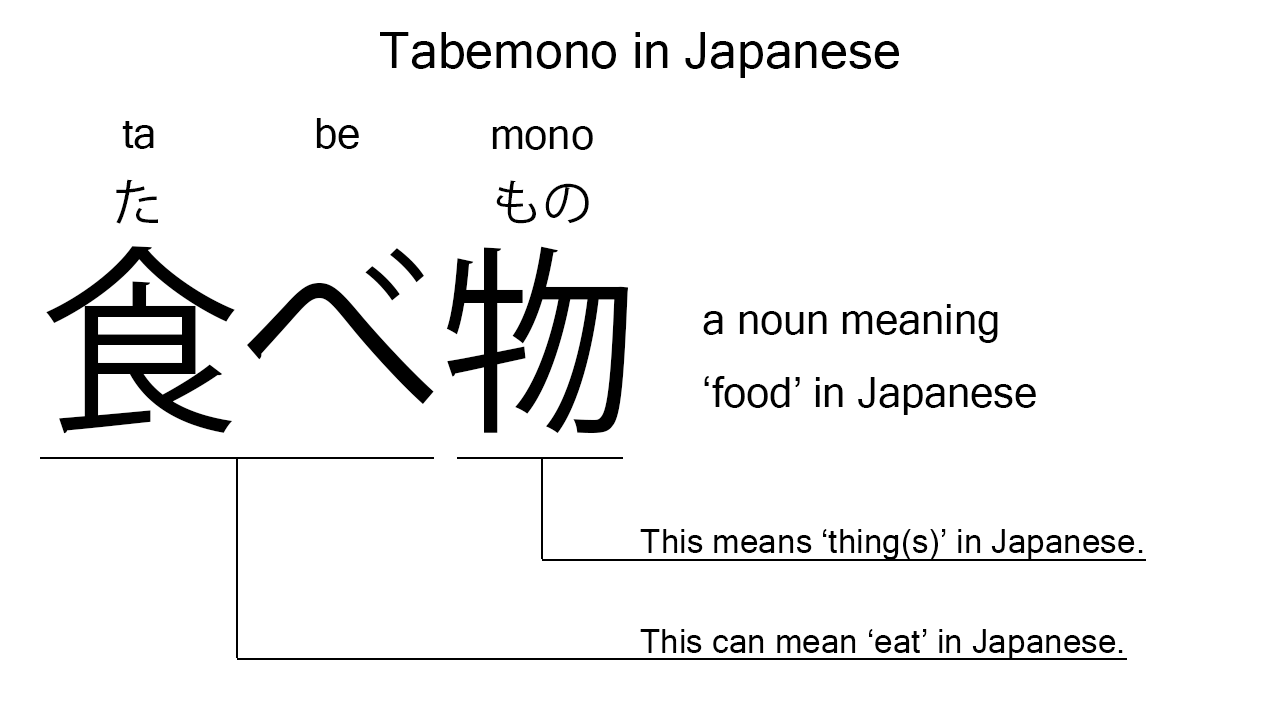What does “tabemono” mean in Japanese?
Native speakers say “tabemono” often to mean ‘food’ in Japanese. Perhaps, some Japanese learners know this word as it is sometimes used in Japanese conversations. In this blog post, however, I will explain this word in detail based on its grammatical components. And also, I will explain how to use it through example sentences. My explanations would help Japanese learners understand “tabemono” more clearly. Then, let’s get started!
Contents
Definition and meanings of “tabemono”
Let me start with the definition and meanings of “tabemono”.
- tabemono – 食べ物 (たべもの) : a noun meaning ‘food’ in Japanese. This can also mean ‘something to eat’ in general.
The definition and meanings are simple and clear. To understand this noun more clearly, however, let me explain its grammatical components in detail, one by one.
What does “tabemono” literally mean in Japanese?
“Tabemono” consists of the following two components:
- tabe – 食べ (たべ) : one conjugation of the verb, “taberu“, which means ‘to eat’ in Japanese.
- mono – 物 (もの) : a noun meaning ‘thing’, ‘stuff’, or ‘matter’ in Japanese. Depending on the word used together, this can also mean ‘something’ or ‘anything’ in Japanese. This can also be found in other words like “kaimono“.
From these two components, we can understand that “tabemono” literally means ‘things to eat’ in Japanese. This literal interpretation is very close to the actual meanings.

When we meet new Japanese words, we should check their grammatical components in detail to understand their meanings clearly and deeply. In many cases, components tell us a lot about the meanings of the words they form. Actually, here, we could get the better understanding of “tabemono” through the detailed check above.
So far, I’ve explained the definition and meanings of “tabemono” together with its grammatical components. Then, let me explain how to use it through the example sentences below.
Example #1: how to say “food” in Japanese
watashi no sukina tabemono wa ichigo desu – 私の好きな食べ物は苺です (わたしのすきなたべものはいちごです)
My favorite food is strawberries.
Below are the new words used in the example sentence.
- watashi – 私 (わたし) : a pronoun meaning ‘I’ in Japanese.
- no – の : a case particle used after a noun or pronoun to make its possessive case. In the example, this is used after “watashi” to make its possessive case, “watashi no“, which means ‘my’ in Japanese.
- sukina – 好きな (すきな) : a na-adjective meaning ‘favorite’ in Japanese. In the example, this works as a modifier in front of “tabemono”.
- wa – は : a binding particle working as a case marker or topic marker. In the example, this works after the noun phrase, “watashi no sukina tabemono”, to make the subject in the sentence.
- ichigo – 苺 (いちご) : a noun meaning ‘strawberry’ in Japanese. This can also work as plural. Learn more about Japanese plural.
- desu – です : an auxiliary verb used after a noun or adjective to make it polite. Probably, this is well known as a part of Japanese desu form. In the example, this is used after “ichigo” to make it sound polite.
This is a typical usage of “tabemono”. In this example, it works together with the na-adjective, “sukina”, to mean ‘favorite food’ in Japanese. Japanese native speakers sometimes use this combination in daily conversations, so it’s worth knowing.
Example #2: another usage of “tabemono”
boku wa mise de tabemono wo kai tai – 僕は店で食べ物を買いたい (ぼくはみせでたべものをかいたい)
I want to buy something to eat at the shop.
Below are the new words used in the example sentence.
- boku – 僕 (ぼく) : a pronoun meaning ‘I’ in Japanese. This is used mainly by boys and young males.
- mise – 店 (みせ) : a noun meaning ‘shop’ in Japanese. This can also work as plural.
- de – で : a case particle used to say where someone does something. In the example, this is used after “mise” to say where the speaker wants to buy something to eat.
- wo – を : a case particle used to make the object word in a sentence. In the example, this is used after “tabemono” to make the object in the sentence.
- kai – 買い (かい) : one conjugation of the verb, “kau“, which means ‘to buy’ or ‘to purchase’ in Japanese. In the example, it has been conjugated for the better connection with its following word.
- tai – たい : an auxiliary verb used after a verb to make its desire form. In the example, this is used after “kai” to make its desire form, “kai tai”, which means ‘to want to buy’ in Japanese.
This is another typical usage of “tabemono”. In this example, it works as the object in the sentence and means ‘something to eat’ in Japanese.
Summary
In this blog post, I’ve explained the definition and meanings of “tabemono” in detail based on its grammatical components. And also, I’ve explained how to use it through the example sentences. Let me summarize them as follows.
- tabemono – 食べ物 (たべもの) : a noun meaning ‘food’ in Japanese. This can also mean ‘something to eat’ in general. This noun consists of “tabe” and “mono” which means ‘to eat’ and ‘things’ respectively in Japanese. So, this noun literally means ‘things to eat’ in Japanese. This literal interpretation is very close to the actual meanings.
- sukina tabemono – 好きな食べ物 (すきなたべもの) : a commonly-used phrase meaning ‘favorite food’ in Japanese. Japanese native speakers sometimes use this phrase in daily conversations.
Hope my explanations are understandable and helpful for Japanese learners.